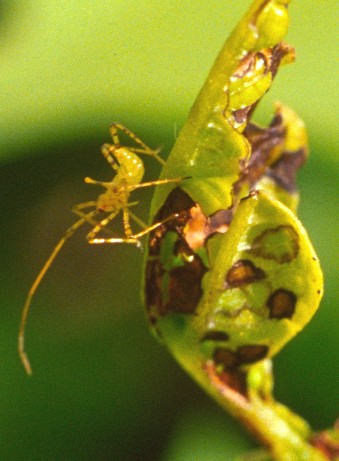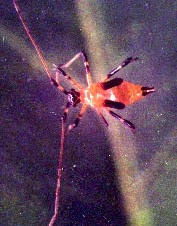|
Class |
Insecta |
|
Order |
Hemiptera |
|
Family |
Miridae |
The
insect is polyphagous, attacking vegetables, orchards and ornamentals. Damage in
sweetpotato is usually not as serious as those in vegetables and fruits.
Asia and Pacific.
Adults and nymphs feed on the young shoots of
sweetpotato. A lesion is formed at the puncture site due to toxic secretions.
Lesions on leaves are dark, and generally clustered towards the leaf centre
adjacent to veins. These lesions may become holes as leaves expand.
Expanding leaves become puckered as the lesions constrict tissue expansion.
Lesions on stems and petioles are light brown, oval shaped and slightly
sunken. Lesions just below the growing tip may result in tip death.
Heavy mirid bug infestation can arrest the crop's growth by killing most tips.
Egg. The egg is tubular with a cap and two
unequal filaments. It measures 2.15 mm long including the filaments and 0.37 mm
wide.
Nymph. The
nymphs
are yellow to orange with 2 pin-like projections arising from the middle of the
mesothorax. The first and second instars
appear ant-like and the arched body is covered with reddish setae as well as the
appendages. Black wing pads are present in later nymphal stages. Mature nymphs
measure 5-6 mm.
Adult. The adult
is elongated (6 mm) with long 4-segmented filiform antenna and bulging compound
eyes. The thorax has a black pin-like projection with microscopic setae present
on the rounded tip. The male and female can be differentiated by their colour.
The males have black head, thorax, and wings and white basal end of the pin-like
projection of thorax, while the females have black wings and yellow orange basal
end of the pin-like projection.
The eggs of this bug are laid singly or in groups on the
soft tissues of the host. Egg incubation lasts 5-6 days with 90% hatchability.
The bug passes through five nymphal instars in 9-13 days. The total
developmental period ranges from 14-16 days. The male to female ration is
1:1.32. Females are capable of laying 1-20 eggs per day during the first week
and gradually decreases in the second week with only 1-2 eggs laid per day.
Young nymphs prefer to feed on the growing tip/shoots of
the host. Later instars feed on the second and third leaf from the tip. The
feeding punctures initially appear water-soaked but turn black after a few
hours. The shoots become deformed and finally dry up. The toxic effect of the
salivary secretions plus mechanical damage due to numerous punctures on the
leaves and shoots may be sufficient to cause death of the tissues.
The insect is a pest on fruits, vegetables and weeds. It
attacks Acalypha wilesiana, Annona muricata, Annona reticulata, Azadirachta
indica, Capsicum frutescens, Capsicum anuum, Citrus madurensis, Dioscorea alata,
Helianthus anuus, Ipomea aquatica, Ipomoea triloba, Ixora coccinea, Mangifera
indica, Manihot esculenta, Mikania cordata, Persea americana, Polyscia sp.
Psidium guajava Ros sp. and Theobroma cacao.
Little or no known effort has been made
to establish control measures against mirid bug due to its status as a minor
pest. However, it is preyed upon by a species of spider, Lycosa
sp., and a reduviid bug which feed on nymphs and adults. An unidentified species
of ants attacks the younger nymphs.
Amalin, D.M. and Vasquez, E.A. . 1993. A handbook on
Philippine sweet potato pests and their natural enemies. International Potato
Center (CIP), Los Baņos, Philippines. 82 p.
Platino, M. G. J. 1988. Biology of the sweet potato mirid
bug, Helopeltis sp. Unpublished BSA Thesis, Visayas State College of
Agriculture, Baybay, Leyte, Philippines.
Vasquez, E. A. and C. E. Sajise. 1990. Pests of sweet
potato: Insects, mites and diseases. Philippine Root Crop Information Service,
Philippine Root Crop Research & Training Center. 65 p.
Contributed by: Erlinda
Vasquez and
Jane O'Sullivan |
Taxonomy
Economic
importance
Geographical
distribution
Damage
Morphology
Biology
and ecology
Host
range
Management
References

Development
of brown to black water-soaked lesions (E. Vasquez).


Lesions
on leaves (E. Vasquez), and on petioles and stem (J.O'Sullivan).
Stem lesions can result in tip death.


Examples of tip destruction by mirid bug (J.O'Sullivan).


Young nymph (J. O'Sullivan) and a mature nymph showing black wing pads
(E. Vasquez).

Adult mirid bug (E. Vasquez). |

